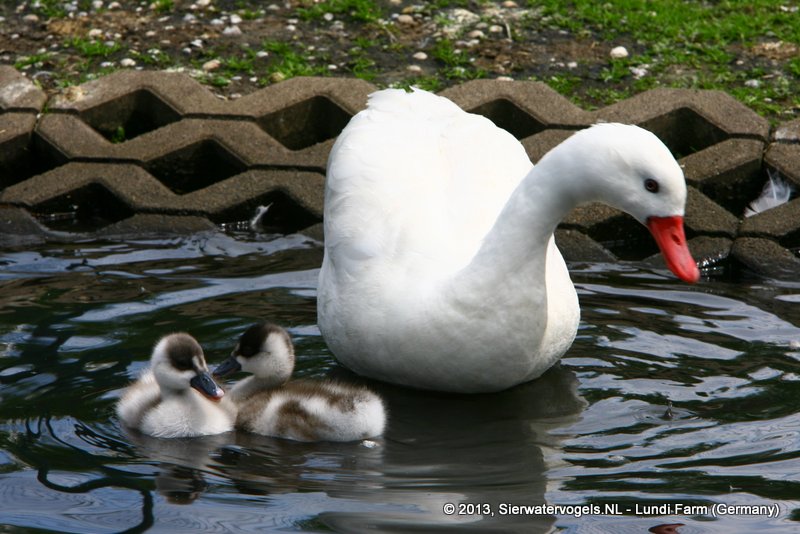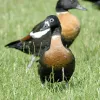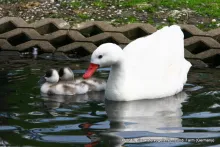
Coscoroba Swan (Coscoroba coscoroba)
Naamgeving
- Nederlandse naam:
- Coscoroba zwaan
- Engelse naam:
- Coscoroba Swan
- Duitse naam:
- Coscorobaschwan
- Franse naam:
- Coscoroba blanc
- Wetenschappelijke naam:
- Coscoroba coscoroba
Taxonomische indeling
- Orde:
- Anseriformes
- Familie:
- Anatidae
- Onderfamilie:
- Anserinae
- Geslacht:
- Coscoroba
Beschrijving
- Uiterlijke kenmerken:
Male:
Have white plumage except for black tips to the outer six primary feathers, although this black is often barely visible on the closed wing. In flight, the black wing tips are conspicuous. The bird has a red beak, legs and feetFemale:
Looks almost identical to the male. But is slightly smaller.Cygnet/Juvenile:
White with brownish pattern on head and upperparts.
- Gedrag:
Found in flocks, usually less than 100 birds, outside the breeding season. Territorial while breeding. Forage in shallow water and also graze along the water's edge.
Maten en Gewicht
- Lengte man:
- De man (woerd) van de Coscoroba Swan heeft een lichaamslengte van ongeveer 86-115 centimeters. De vrouw (pop) heeft een lichaamslengte van ongeveer 86-115 centimeters.
- Gewicht man:
- Het mannetje weegt ongeveer 3800-5400 gram. Het vrouwtje weegt ongeveer 3200-4500 gram.
Het gewicht is notoir variabel en kan alleen als indicatie worden gebruikt!
- Notitie:
Coscoroba swans require large area of high-quality, preferably running, water and a good grazing area. Coscorobas are more delicate than most swans and natural and/or artificial shelter should be provided for protection in severe weather.
This species is less aggressive than most of the swans and they are not generally aggressive outside the breeding season, but they are usually more aggressive and territorial during nesting season (some individuals are more aggressive than others). It may be possible to keep more than one pair in a large enclosure (e.g. three pairs reported to be kept successfully in a one hectare enclosure); in smaller enclosures they may or may not tolerate other species, depending on the temperament of individual birds.
Coscorobas are bred sporadically rather than easily, but established pairs usually continue breeding once they have started. Eggs are laid on a large pile of vegetation, laying usually occurring from early April to the end of May. They frequently lay a second clutch if the first clutch is removed or if the cygnets are removed soon after hatching; they may lay a third clutch particularly if they are not allowed to incubate their previous clutches. Cygnets may be parent incubated and hatched, or parent incubated until just before hatching then hatched in an incubator and hand-reared. These swans are not always good sitters - artificial incubation and hand rearing may be required; they may also be broody hatched and reared. Cygnets are easy to rear on Lundi Premium. Whether broody or hand reared, fresh clean turf and protection from draughts and rain should be provided.
Coscoroba swans do not appear to hybridise.
- Breeding:
- Het vrouwtje Coscoroba Swan legt doorgaans zo'n 5-9 whitish cream eieren het broeden duurt 32-35 dagen.
- Kunstmatig broeden:
De ideale relatieve luchtvochtigheid voor het uitbroeden van de meeste watervogeleieren is 55% voor grondbroeders en 40% bij holenbroeders. De temperatuur is meestal 37,4° C. Stel ventilatie in zoals aanbevolen door de fabrikant van de broedmachine. Eieren moeten minimaal 4 keer per dag automatisch of met de hand worden gedraaid. Naarmate de vrucht zich ontwikkelt, verliest het ei water en wordt de luchtzak groter. Bij normale ontwikkeling van een ei met een incubatietijd van 32-35 dagen neemt de luchtzak ongeveer een derde van het ei in beslag, dit bij drie dagen voor uitkomst. Reinheid is van vitaal belang en idealiter moet de luchtvochtigheid worden verhoogd tot 65% nadat de eerste tekenen van uitkomst zichtbaar worden.
- Ringdagen:
- Aanbevolen passende ringmaat voor de Coscoroba Swan is 20 mm.De gesloten pootring kan alleen aangebracht worden bij een jonge swan van ongeveer 14-16 dagen oud.
- It doesn't matter what leg that you band, but it's good to have a consistent system. Suggested: Left leg = Female, Right leg = Male
- Onderhoudsvoeder:
-





Floating full food for all sea ducks, green ducks, eider ducks and geese, especially in the moulting and breeding phase ideally suited. Packed with wholesome raw materials, natural vitamins and trace elements, this performance food with a protein content of 30% forms the basis for lifelong vitality.
- Toepassing:
CITES II (B1)


